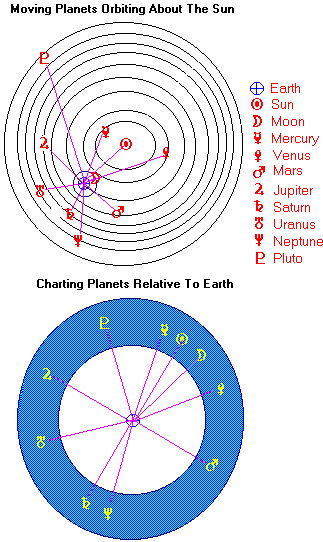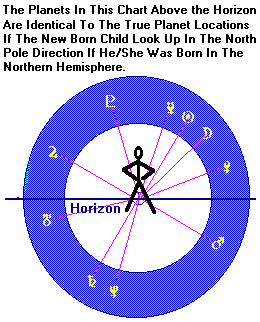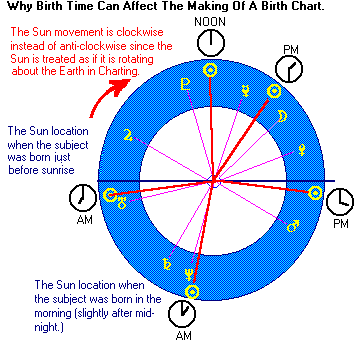The angular distance between two planets in a birth chart is known as their aspects a key factor in conducting an astrological analysis. Based on compiled data, astrologers can look into the aspects of a person’s planets and reveal his or her positive and negative personality traits.
Planets are in aspect (interpretable) when they are of a certain specific angular measurement from each other. Each aspect has a standard symbol and measurement. Some are less noticeable than others, leading to strong, moderate and weak aspects.
Since not many planets will exactly measure at a specific angular displacement such as 90 degrees, astrologers allow the use of orbs -- that is a number of degrees which are either more or less than the exact aspect. The standard aspects and orbs are listed below:
Strong Aspects | |||
| Name | Symbol | Angular Measurement (degrees) | Orb (degrees) |
|---|---|---|---|
| Conjunction | 0 | 5 - 8 | |
| Opposition | 180 | 5 - 8 | |
| Square | 90 | 5 - 8 | |
| Trine | 180 | 5 - 8 | |
Moderate Aspects | |||
| Name | Symbol | Angular Measurement (degrees) | Orb (degrees) |
| Sesquiquadrate | 135 | 1 - 2 | |
| Sextile | 60 | 3 - 5 | |
Weak Aspects | |||
| Name | Symbol | Angular Measurement (degrees) | Orb (degrees) |
| Semi-Sextile | 30 | 1 - 2 | |
| Quincunx | 150 | 1 - 2 | |
A birth chart is a map of the heavens as the newborn child would see it from the place of his or her birth, except that it also includes the sky below the horizon. There are ten moving planets in the chart with which astrology is chiefly concerned. To determine the location of the Earth, astrologers use classical astronomical theory to perform planetary calculations.
The calculations involve fixing the planet Earth and determining the other planets in the solar system relative to it (as if all the planets rotate around the Earth). In the symbolic terms of astrology, the center of the chart represents Earth. There are 12 equal signs which form an encircling band along the ecliptic, each sign occupying a fixed 30 degree field. Against these fields move the planets, passing at various rates out of one sign and into the next in a perpetual circuit.


As the planets move, the angles they form with Earth can be measured for any given moment. In astrology, the moment of birth is taken as the decisive time in a person's life, and the birth chart is calculated with the angular degrees that show how the planets appeared in the heavens at that precise moment. In this way, a person’s birth chart reveals a pattern unique for his or her time and place of birth.


Once a birth chart is calculated, an astrologer interprets the person's life according to the positions of the planets in different Signs, Houses and Aspects based on compiled statistical interpretation data collected over the past 6,000 years.
The Sun is associated with power.
The House that the Sun occupies will be strongly emphasized, with all the activities of that House of great importance to the person throughout his or her life. The positive traits of the sun are creativity, affection and generosity. The most likely negative trait is arrogance.
The Moon is associated with instinct and cyclical changes.
The Moon is the second most important planet aside from the Sun, and is associated with habits, emotions, family and social interaction. Positive traits of the Moon include imaginativeness, business acumen, maternal instinct and patience. Negative traits include stubbornness, unreliability and irrational behavior.
The keyword of Mercury is communication.
Mercury is associated with intellect, science and mental perception. The positive characteristics are good memory, logic and communication skills. The negative traits are argumentative behavior, nervousness and sarcasm.
Fire and energy come to mind with Mars a powerful planet viewed in ancient times as the bringer of wars.
Aggression, quickness in action and other traditional aspects of masculinity are always associated with Mars. Its positive traits are strong leadership qualities, competitiveness, a love of freedom, and a dedication to hard work. The negative traits include being boisterous and quarrelsome.
The keywords of Venus are love and harmony.
Venus is associated with feelings, love, beauty, arts and fashion. The positive traits of Venus are being friendly, well-mannered, artistic and lovable. The negative traits are being selfish and unrealistically romantic.
Limitation and hardship are the main attributes of Saturn.
Saturn is associated with slow movement, difficulty, and tension. Because Saturn is a planet that tests the success or tenacity of a person's action, it is positively associated with perseverance and fortitude although it can also be associated with ill health.
The positive traits of Saturn are trustworthiness, tenacity, and discipline. The negative traits are self-pity and a tendency to depression.
The keyword of Jupiter is expansion.
The House in which Jupiter is found usually is associated with very favorable outcomes in that department of life. The expanding quality of the planet is also related to the physical size of Jupiter -- the largest planet in the solar system.
Positive traits are compassion, optimism and good sportsmanship. Negative traits are extravagance, irresponsibility and over-indulgence.
The keyword of Neptune is unknown.
Neptune may reflect the hidden potential capability of a person. The planet’s positive traits are subtlety, artistic nature and sensitivity. The negative traits are indecisiveness, carelessness and unworldliness.
Sudden changes best represents Uranus.
Uranus is associated with modern science, medicine, sex and communications. The positive traits of the planet are inventiveness and originality. The negative traits are sexually perversion, abnormality and impulsiveness.
Due to its relatively recent discovery (1930), astrologers are still not certain what Pluto’s key associations are.
Many associate Pluto with a new beginning (or the end of a cycle) of a life event, often linking it to business, as well as hidden and unconscious power.
Pluto’s positive traits are financial astuteness and the ability to start new in unfavorable circumstances. The negative traits are underworld association and seediness.
An astrologer assumes that the Earth is a fixed point and that all other cosmic bodies revolve around it once a day. He or she then applies this 24-hour system to the birth chart.
The main circle of the chart is divided into 12 equal segments. One segment or House equals two hours out of the total 24 hours. Houses are not equally divided and there have been numerous different House systems derived in the past 6,000 years. Today, most astrologers employ the most popular Placidous House system to divide the birth chart into 12 Houses.
Houses relate to everyday activities: the first to personality, the second to possessions, and so on. A planet or planets placed in a particular House affect the area of life represented by that House in a manner typical of the planet. The House must be considered according to the sign in which the cusp or starting point of the particular House falls.
The areas of life represented by the 12 Houses are as follows:
| House | Area of Life |
| 1 | Personality, health, disposition. |
| 2 | Possessions, wealth, worldly resources. |
| 3 | Family ties, education, short journey. |
| 4 | Home, domestic life, parenthood. |
| 5 | Creativity, children, speculation, love affairs. |
| 6 | Work, subordinate. It is the attitude towards services to the outside world. |
| 7 | Partnership in love and business. |
| 8 | Inheritance, life and death, sex. |
| 9 | Philosophical views, higher forms of education. |
| 10 | Career, ambition, all matters outside the home. |
| 11 | Friends, acquaintances, intellectual pleasures. |
| 12 | A need for seclusion, self-sacrifice. |
The 12 signs are separated into three qualities --CARDINAL,
FIXED and MUTABLE.
By studying the combination of different planets in these three different Qualities, plus the Elements of their Signs, astrologers
can draw a complete personality profile of a subject.
CARDINAL -- Aries, Cancer,
Libra and Capricorn. Enterprising and outgoing.
FIXED -- Taurus, Leo, Scorpio and
Aquarius. Resistant to change.
MUTABLE -- Gemini, Virgo, Sagittarius and Pisces.
Adaptable and changeable.
Each sign of the same quality expresses its quality differently. For example, Aries and
Cancer are both Cardinal but Aries is of Fire and Cancer is of Water. Therefore, while both are signs of an enterprising nature,
Aries will show more enthusiasm at the start of a job whereas the Cancer will display their emotions more evenly and consistently
throughout.
The significance of Elements and Qualities must also be viewed in context with the
Aspect interpretation.
The 12 signs are further separated into four elements, namely FIRE,
EARTH, AIR and WATER. By examining the
different planets in these signs together with their Qualities, astrologers can draw a more in-depth profile of a subject.
FIRE -- Aries, Leo. Sagittarius. People of Fire signs are explosive, volatile, energetic.
They are leaders, inventors and adventurers. Their weaknesses are their tendency to work to extremes and burn themselves out. Fire
attributes are best counterbalanced by the Earth signs.
EARTH -- Taurus, Virgo, Capricorn.
People of Earth signs are practical, cautious and reliable. They generally lack imagination and creativity.
AIR -- Gemini, Libra, Aquarius. Air signs denote intellectual activity, thought and philosophy.
People who possess many planets in the Air signs are good planners. Those without Air signs may have difficulty in communication or
expressing themselves artistically. An excess of planets in Air signs is best counterbalanced by Water signs.
WATER -- Cancer, Scorpio, Pisces. Those with planets in the Water sign moderate the practicality
of Earth, the ideas of Air and the careless energy of Fire. Having many planets in the Fire sign usually indicates a person is lively,
emotional and enthusiastic.
Although this interpretation is simplistic and direct, astrologers must also consider the
effect of the Qualities and
Aspects of the subject's birth chart to draw a complete personality
profile.
In classical astrology, however, all interpretations and predictions are personalized, based on the subject’s own
unique birth chart, with the analyses of their aspects,
signs, elements,
qualities and houses
also taken into account.
A horoscope is also known as a transit analysis. Using astronomical calculations,
astrologers can locate the positions of the ten planets at any specific time and plot them on a birth chart. Since
there are two sets of planets, the natal planets (the planets at the time the subject was born) and the transit planets
(the planets at the time of interest), there are aspects between the planets.
These aspects are unique to each birth chart. So analyzing the transit aspects and the transit planets in different
houses and signs lets you interpret daily horoscopes much more accurately.
The Ascendent in a birth chart is known as the rising sign. It is the starting point of the first house in a chart. Contrary to the standard horoscopes in the newspaper, where the personality of a person is based on the Sun Sign, classical astrologers usually put emphasis on the characteristics of the first House, or Ascendent, to project a personality profile.
On the birth chart, the Midheaven is the point where the Sun is found at midday. The sign where the Midheaven is found not only has a strong bearing on a person's outward expression -- lifestyle, career, attitude, etc. -- but also in events over which they have no direct control.
The Midheaven represents ego, and the characteristics that are associated with the sign in which the Midheaven is found are all usually expressed in an external manner.
The keyword to describe Aries is assertiveness. The positive traits of the sign lead to personalities that are daring, enterprising, courageous, highly spirited and freedom loving. The negative traits are being selfish and temperamental.
The keyword of Taurus is permanence.
The positive traits are being reliable, persistent, respectable and friendly. Negative traits are stubbornness, possessiveness, lack of flexibility and laziness.
The keyword of Gemini is communication.
The positive traits are adaptability, intellectuality, wittiness and highly spiritedness. Negative traits include being unpredictable, inconsistent, undetermined, nervous and superficial.
The keyword of Cancer is sensitivity.
The positive traits are having a kind heart, gentleness, sensitivity, with good parental instincts while being cautious financially. Negative traits are hyperactivity and being overly sensitive and emotional.
The keyword of Leo is power.
The positive traits are self assertiveness, generosity, leadership, and flamboyance. The negative traits are bullishness, arrogance and a hunger for power.
The keyword of Virgo is critical.
Positive traits include being analytical, scientific, logical, modest, and meticulous. The negative side is being overly critical, fussy and finicky.
The keyword of Libra is harmony.
The positive traits include being pleasant, romantic, easy going, friendly and diplomatic. The negative traits include being flirtatious and indecisive.
The keyword of Scorpio is intensity.
The positive traits of Scorpio are determination, diligence, charm, refinement and a sense of purpose. The negative traits are being vindictive, jealous, inflexible and introverted.
The keyword of Sagittarius is openness.
The positive traits include being flexible, freedom loving, joyful, youthful, open-minded, extroverted, sincere and friendly. The negative traits are being tactless, irresponsible and not able to finish what you start.
The keyword of Capricorn is prudence.
The positive traits are being cautious, disciplined, financially wise, humorous and reliable. The negative traits are stubbornness, inflexibility, frugality and meanness.
The keyword of Aquarius is humane.
The positive traits are being humanitarian, a strong advocate of peace and harmony, inventive and loyal. The negative traits are being eccentric, sexually perverse and rebellious.
The keyword of Pisces is impressionable.
The positive traits are being humble, kind, receptive and sympathetic. The negative traits include being indecisive, careless and secretive.